Development of a Prototype for Promoting Self-Efficacy in Digital Competence for Accountants in Organizations
Dollahas Patpoom1 and Piyapong khaikleng2*
1Master degree student in the Applied Psychology, Srinakharinwirot University, Thailand
2Lecturer in the College of Creative Industry, Srinakharinwirot University, Thailand
Submission: June 15, 2021; Published: June 22, 2021
*Corresponding author: Dollahas Patpoom, Master degree student in the Applied Psychology, Srinakharinwirot University, Thailand
How to cite this article: Dollahas Patpoom and Piyapong khaikleng*. Development of a Prototype for Promoting Self-Efficacy in Digital Competence for Accountants in Organizations. Psychol Behav Sci Int J. 2021; 17(2): 555957. DOI: 10.19080/PBSIJ.2021.17.555957
Abstract
Positive self-talk could increase an individual’s competence. Thus, it is considered as one of the factors to develop human proficiency. The objectives of this research were to 1) analyze experiences and needs to enhance accountants’ self-efficacy in digital competence by applying the user experience research, 2) design and develop the positive self-talk prototype to enhance accountants’ self-efficacy in digital competence from the user experience and need analysis, and 3) verify possibility of the developed digital competence enhancement prototype from the accountants’ perspectives. This research applied user experience research and design research to study 116 accountants in private company. The study proceeded in three phases. Phase one, data collection was conducted through an online survey. The data analysis results indicated that accountants had a high degree of experience in positive self-talk and the most needed self-efficacy in the digital competence area was problem solving. Phase two, the results from phase one were used as design principle to design activities. Phase three, the possibility of the activities developed in phase two was verified by 116 accountants through online questionnaires. In conclusion, positive self-talk prototype from the user experience and need analysis enhance accountants’ self-efficacy in digital competence in accountants’ perspectives.
Keywords: User Experience; Needs; Prototype development; Accountants; Digital competence. Positive Self-Talk
Introduction
The digital economy uses information technology to play an important role in socioeconomic drive, regarding business operations, production, and service. The entry of information technology has benefited society and the economy in terms of cost reduction, business operation, competitive ability increment, and promoting a better quality of life for people in the society [1]. An accountant is one of the professions associated with the digital economy. Artificial Intelligence (AI) or robots has been used to help in accounting, particularly in work with a clearly standardized format. Robots are highly accurate and faster than people. There are concerns that accountants will be replaced by robots or not [2]. As a result, accountants have to improve their digital competence and adjust their roles to increase self-worth, which can be achieved by learning and applying technologies to benefits the organization [3-5]. There is a lot of research about digital competence in various fields of professions. However, the number of researches about accountant’s digital competence is still limited. The research by Mannila et al. [6], which is the most similar context to an accountant, had studied digital competence in five areas including information and data literacy, communication and collaboration, digital content creation, safety, and problem-solving. For literature review about the digital competence-promoting activities [7], revealed that digital competence was related to self-efficacy in technology, which can be achieved with positive self-talk.
Likewise, the concept of Walter et al. [8], “Effects of Self-Talk Training on Competitive Anxiety, Self-Efficacy, Volitional Skills, and Performance: An Intervention Study with Junior Sub-Elite Athletes”. The study indicated that during an experiment, self-talk training can encourage the athletes to have more self-efficacy, inspiration, and self-confidence. Learning self-talk in different ways or training until it becomes routine may help to improve athletic performance. Based on the literature review, it appears that the studies about the effects of self-talk on digital competence lacked the context of accountants in the digital era. For this reason, it is necessary to study the accountants’ experiences and develop a prototype regarding the accountants’ digital competence enhancement with self-talk. The developed prototype should be practical for the changing digital economy. Therefore, the findings of user experience and accountants’ needs analysis are beneficial for the prototype development to promote the digital competence of accountants in the digital era and enhance their abilities to perform tasks and achieve the organization’s goals.
Aim and Objectives of the Study
a) To analyze experiences and needs about self-talk to enhance accountants’ digital competence by applying the user experience research
b) To design and develop the self-talk prototype to enhance accountants’ digital competence from the user experience and needs analysis
c) To verify the possibility of the developed digital competence enhancement prototype from
d) the accountants’ perspectives.
Theoretical Framework& Literature Review
Digital competence
Hatlevik et al. [9] defined digital competence as the skills, knowledge, and attitudes that make learners able to use digital media for participation, work, and problem solving, independently and in collaboration with others in a critical, responsible, and creative manner. According to Calvani et al. [10], digital competence refers to the ability to face and explore new technological contexts in terms of data analysis, problem solving, evaluating and exchanging knowledge with others on the digital platform with a sense of responsibility. Mannila et al. [6] stated that the digital competence framework, identified by the European Commission, has key components in five areas including 1) Information and data literacy, 2) Communication and collaboration, 3) Digital content creation, 4) Safety, and 5) Problem solving. The digital competence can be evaluated from self-efficacy, with the characteristics of rating scale, focused on measuring self-efficacy in digital competence [11]. This section consists of 4 topics: 1) meaning of self-efficacy; 2) self-efficacy components; 3) theories of self-efficacy; 4) the aspects of selfefficacy measurement
Self-efficacy
Bandura 1997 cited in Lunenburg, [12] stated that selfefficacy is a person’s belief that they are capable of performing a particular task successfully, and Schunk [13] defined selfefficacy as a person’s awareness of their own capability level and understand how hard it is to achieve the goal. Bandura (1997 cited in Lunenburg, [12] explained that self-efficacy comprises four components, which are 1) past performance, 2) vicarious experience, 30 verbal persuasion, and 4) emotional cues
Positive self-talk Positive self-talk
Harrell [14] has defined positive self-talk as an avoidance of negative behavior through positive self-talking. Zimmer [15] explained positive self-talk as an individual’s act of talking to themselves through their particular emotional experiences. Nelson Jones (1990 cited in Mamah, [16]) defined self-talk as the communication of an individual to themselves to maintain positive emotional and mental state.
Hardy et al. [17] formulated the theory of positive self-talk, that there are two main factors that lead to self-talk, which are 1) situational factors and 2) personal factors. The situational factors include: task difficulty, suitability of the circumstances, and competitive settings. The personal factors include: cognitive processing preferences, belief in self-talk, and personality traits. These two factors, when operated with the four components mechanism mentioned above, can result in an effective performance. Walter et al. [8] has developed the framework of self-talk of Hardy et. al. [17] using his own experiments with addition of two personal factors, which are age and gender. As well as the training mechanisms that have been proven to be effective, including: routine, systematic knowledge, acceptance, commitment, familiarity, belief in self-efficacy, intrinsic interest, and motivation. In addition to demonstrating the situational and personal factors that operated by self-talk mechanism according to the model of Hardy et al. [17], this framework has illustrated the use of motivational and instructional self-talk that two conceptual triangles bind in the figure. This example was the study in athletes, using self-talk to improve participants’ motor skills through four different advices, the results were as follows: 1) using self-talk to remind conscious move which leads to more effective movement and resulted in improved motor skills; 2) using self-talk to remain focus on training and increase attention resulted in reduced interfering thoughts; 3) using self-talk to regulate emotional reactions resulted in decreased anxiety and more control over emotional states; and 4) using self-talk to encourage themselves, which could promote their self-efficacy, resulted in increased self-confidence. These advice and results were evidence that the above training mechanisms could result in improved athletic performance (Figure 1).
The positive self-talk mechanisms to promote self-efficacy in this research consists of three mechanisms, including: 1) talking with positive encouraging messages and work strive, 2) giving examples of competence-motivating messages, and 3) creating competitive situations and encouragement from mentors or supervisors. Together with the fact that the studies in context of accountants are unavailable. Therefore, it is an interesting thought to apply this proven fact with the accountants’ context and to develop a prototype to enhance accountants’ self-efficacy in digital competence.
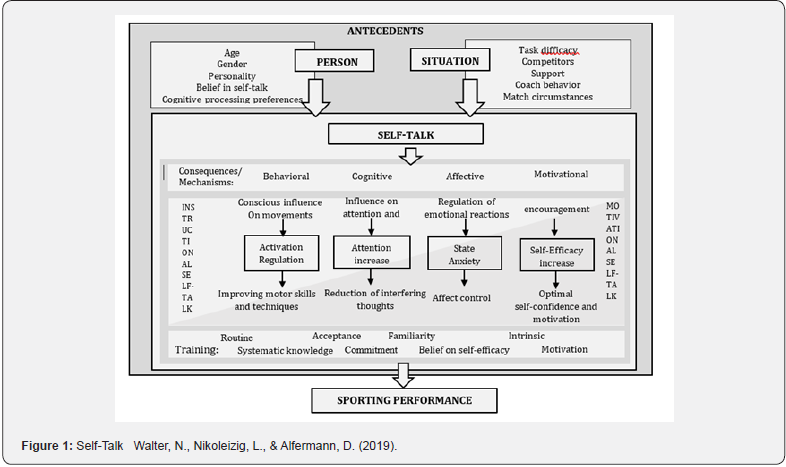
Method
The study was performed in three phases.
Phase one: Empathize and Define the Problem
Empathize: analyze accountant’s user experience in positive self-talk, needs for self-efficacy in digital competence, and find the correlation between the self-talk model of Walter et al. [8] and accountants’ self-efficacy in digital competence. The study started with defining a definition and created a questionnaire using the Likert scale. The questionnaire consists of 3 parts, which are 1) accountants’ user experience in positive self-talk in four aspects including roles, emotions, attitudes, and behaviors, which were applied from the concepts by Wongwanich [18]; 2) The needs for self-efficacy in digital competence were analyzed in five areas according to the prior research by Mannila et al. [6], including information and data literacy, communication and collaboration, digital content creation, safety, and problem-solving; and 3) Design principle of positive self-talk consists of three mechanisms which are 1) talking with positive encouraging messages and work strive, 2) giving examples of competence-motivating messages; and 3) creating competitive situations and encouragement from mentors or supervisors. There are 95 questions in total. The questionnaire was then evaluated by experts to judge the validity of the content. All variables of the instrument have the IOC value between 0.933-1.00. Thereafter, the questionnaire was tried out with 80 non-population accountants. The Cronbach’s Alpha value was between 0.76-0.91 and the Discrimination Index of all questions has a statistically significant value of 0.001. After the approval of permission to collect research data, data collection was conducted through an online survey with a total of 116 accountants. Participants had to log in by E-mail to enter the survey.
The accountants were subsequently classified into two groups: accountants with high self-efficacy in digital competence and accountants with low self-efficacy in digital competence. The collected data were used to analyze the self-talk prototype to enhance accountants’ self-efficacy in digital competence for its possibility and compared the difference between these two groups. The questionnaire was then checked for the completeness and correctness of the responses from 116 accountants and the data was coded and graded for further processing of information.
Define the problem: The information obtained from the study and surveys were analyzed to determine the main problem of accountants. Basic information of the population was analyzed using descriptive statistics and percentages; The positive selftalk experiences were analyzed using average value and Standard Deviation (S.D.); The needs for self-efficacy in digital competence were analyzed with the Modified Priority Needs Index (PNImodified); The positive self-talk design principle used Simple Linear Regression to analyze the correlation of accountants’ digital competence levels.
Phase two: Ideation and Prototype
Ideate: the results from phase one were set as a positive self-talk principle that affects accountants’ self-efficacy in digital competence, then designed activities following by the principle.
Prototype: The developed principle and activities were verified and adjusted by experts. Then, the definition and questionnaire were created to evaluate the possibility of the developed digital competence enhancement prototype activities. The online questionnaires were sent to 116 accountants. The instrument evaluation was found to have an IOC value of 1.00.
Phase three: Test
Test: the possibility of the activities developed in phase two was verified by 116 accountants through online questionnaires. Participants had to log in by E-mail to enter the survey for identification and subsequently classified into two groups: accountants with high self-efficacy in digital competence and accountants with low self-efficacy in digital competence. The data was then coded and graded for further processing of information. The data were analyzed with Frequency, Percentage, Mean, and Standard deviation.
Result
Study results in phase one: experiences and needs to enhance accountants’ self-efficacy in digital competence The analysis of experience in positive self-talk showed that accountants had a high degree of experience in positive self-talk in all aspects. Attitudes were the aspect with the highest average value (M=3.78, SD = 0.78). Followed by emotions (M=3.62, SD = 0.78), roles (M=3.59, SD = 0.82), and behaviors (M=3.57, SD = 0.81) respectively as shown in the following Table 1.
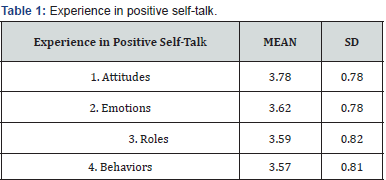
The analysis of the needs for self-efficacy in digital competence showed that the problem-solving area was the most needed competence (PNI Index = 0.23). Followed by information and data literacy (PNI Index = 0.17), digital content creation and safety (PNI Index = 0.16), and communication and collaboration (PNI Index = 0.11) respectively as shown in the following Table 2.

The analysis of the correlation between the model of positive self-talk and accountants’ digital competence level was performed using Simple Regression Analysis. The result can be used to predict the probability of digital competence with the value of Adjusted R Square = 0.280 and was positively correlated at the statistically significant level of 0.01. This means the model of positive selftalk by Walter et al. [8] (modified model, based on Hardy et al. [17]) could be used to determine the digital competence of the accountants. The result is shown in the following Table 3.
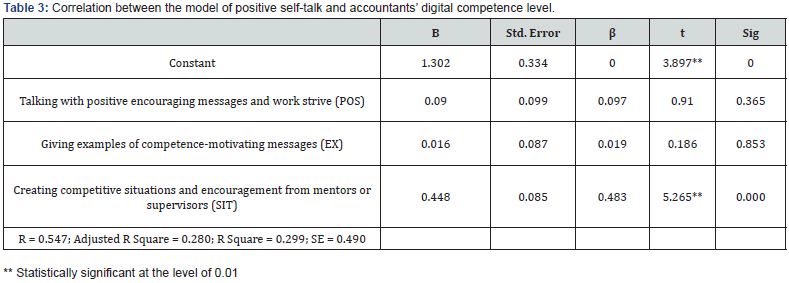
Study Results in Phase Two: Ideation and Development of a Prototype to Enhance Accountants’ Self-Efficacy in Digital Competence
The Activities Design Based on the Study Results from Phase One
The researcher had designed a design principle of positive self-talk consists of three mechanisms which are 1) talking with positive encouraging messages and work strive, 2) giving examples of competence-motivating messages, and 3) creating competitive situations and encouragement from mentors or supervisors.
According to the Simple linear regression analysis demonstrated in the previous phase, the model of positive self-talk by Walter et al. [8] (modified model, based on Hardy et al. [17]) was positively correlated with accountants’ digital competence, which was statistically significant at the level of 0.01. Therefore, the model was used to define four activities as follows: The first activity, “mind-opening, accepting, and learning about positive self-talk” aims to introduce positive self-talk to accountants and exchange messages which promote the accountants’ digital competence. This is a one-time event because the user experience research found that accountants already had a high degree of experience in all aspects.
The second activity, “positive talking experiments in a real competitive situation”. This activity will let accountants use positive self-talk in a knowledge-sharing contest, in which participants will share the solutions to digital problems encountered in their commonly used programs.
The third activity, “exploring example messages and trying positive self-talk”. This activity aims to respond to the needs in different areas, through the example of positive self-talk regarding five areas of digital competence. According to the study of needs for competence, the problem-solving area was the most needed competence, followed by information and data literacy, digital content creation, safety, and communication and collaboration respectively. Therefore, in this activity, the participants will receive examples of positive self-talk corresponding to their needs and apply it for themselves.
The fourth activity, “positive self-talking for sustainable success in the digital age”. This activity aims to encourage the exchange of messages and feedback of the previously received messages. The accountants will be able to improve their performance and apply the most practical positive self-talk for sustainable success with themselves to achieve maximum benefits of the prototype for promoting self-efficacy in digital competence.
Study Results in Phase Three: Possibility of Activities
The analysis of the possibility of activities was found that activities was possibility. Accountant rated highest on the suitability of activities (M=4.23, SD=0.73), followed by applicable (M=4.22, SD=0.77), beneficial (M=4.14, SD=0.75), and easiness (M=4.13, SD=0.78) respectively as shown in the Table 4.
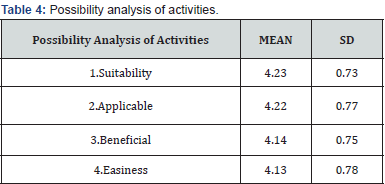
The Comparative Study between Two Groups with Different Competence Levels
The positive self-talk experiences in accountants classified by self-efficacy in digital competence levels was analyzed in four aspects including roles, emotions, attitudes, and behaviors, with five components in each aspect. The analysis of two comparative groups was found that accountants with high selfefficacy in digital competence have the highest average value on attitudes (M=3.90, SD = 0.78), followed by roles (M=3.78, SD = 0.74), behaviors (M=3.78, SD = 0.78), and emotions (M=3.75, SD = 0.74), respectively. Accountants with low self-efficacy in digital competence have the highest average value on attitudes (M=3.65, SD = 0.77), followed by emotions (M=3.49, SD = 0.80), roles (M=3.40, SD = 0.85), and behaviors (M=3.37, SD = 0.79), respectively as shown in the following Table 5.

The Analysis of the Needs for Self-Efficacy in Digital Competence, Which Classified by the Accountants’ Self- Efficacy in Digital Competence Levels
Digital competence levels were found that accountants with high self-efficacy most needed for competence in information and data literacy (PNI Index = 0.08), followed by problem-solving (PNI Index = 0.03), and digital content creation (PNI Index = 0.02), respectively, without needs for digital competence in safety (PNI Index = 0.00) and communication and collaboration (PNI Index = -0.02). While the group with low self-efficacy needs competence in problem-solving (PNI Index = 0.51) the most. Followed by safety (PNI Index = 0.37), digital content creation (PNI Index = 0.36), communication and collaboration (PNI Index = 0.29), and information and data literacy (PNI Index = 0.27), respectively as shown in the following Table 6.

The Analysis of the Positive Self-Talk Model for Accountants Classified by Self-Efficacy in Digital Competence Levels
The accountants with high self-efficacy in digital competence had the highest scores on talking with positive encouraging messages and work strive (M=4.07, SD = 0.76). Followed by giving examples of competence-motivating messages (M=3.95, SD = 0.71), and creating competitive situations and encouragement from mentors or supervisors (M=3.83, SD = 0.80), respectively. The accountants with low self-efficacy in digital competence had the highest scores on talking with positive encouraging messages and work strive (M=3.80, SD = 0.75), followed by giving examples of competence-motivating messages (M=3.64, SD = 0.82), and creating competitive situations and encouragement from mentors or supervisors (M=3.34, SD = 0.89) respectively as shown in the following Table 7.
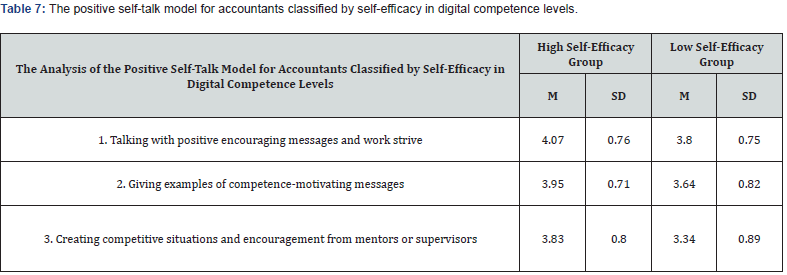
The Analysis of the Possibility of Activities, Classified by Accountants’ Self-Efficacy in Digital Competence Levels
Digital competence level was found that accountants with high self-efficacy in digital competence rated highest on the suitability of activities (M=4.23, SD=0.73), followed by applicable (M=4.13, SD=0.77), beneficial (M=4.04, SD=0.78), and easiness (M=4.02, SD=0.82). While the accountants with high self-efficacy in digital competence rated highest on the applicable (M=4.30, SD=0.76), followed by beneficial (M=4.24, SD=0.72), easiness (M=4.23, SD=0.73), and suitability (M=4.21, SD=0.75) respectively as shown in the Table 8 (Figure 2).

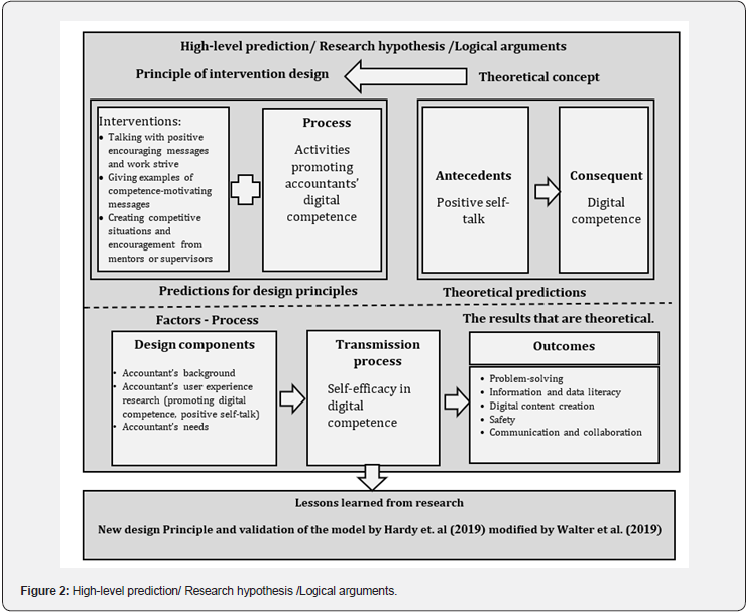
Self-efficacy in the digital competence of accountants from the result is at a moderate level and the needs for self-efficacy in five areas of digital competence are in the positive direction. Problems-solving is the most needed competence, followed by information and data literacy, digital content creation, safety, and communication and collaboration. Which consistent with the Federation of Accounting Professions Under the Royal Patronage of His Majesty the King [2] and Boonchauy [1] stated that the entry of technologies is the reason for the accountants to change their roles, to learn, and to apply more technologies to work.
Three mechanisms of positive self-talk design principle from the study which are 1) talking with positive encouraging messages and work strive, 2) giving examples of competencemotivating messages, and 3) creating competitive situations and encouragement from mentors or supervisors. It was found to be the factor that influences accountants’ self-efficacy in digital competence according to the Simple Linear Regression Analysis, and it was correlated with the principle about the effects of positive self-talk on self-efficacy by Hardy et. al, modified by Walter et al. [8].
Conclusion and Recommendations
The prototype for promoting self-efficacy in digital competence for accountants was developed from the experience and needs of the accountants. This has resulted in a prototype that matches the self-efficacy in digital competence in accountants’ context. This prototype is beneficial to the HR department in driving organizational policies to improve accountants’ selfefficacy in digital competence. It is also useful for the academic field to perform further research in different contexts and enable further testing and validation of design principles to be used in a wide range.
References
- Boonchauy N (2020) The age of disruptive technology and the development of innovative accountants. Journal of Business Administration and Social Sciences Ramkhamhaeng University 3(1): 15-26.
- Federation of Accounting Professions Under the Royal Patronage of His Majesty the King (2020) The Important Key of Skill and Technologies for Management accountants.
- Department of Business Development (2016) The importance of accountants to businesses in the digital economy and society.
- Sirisak K (2016) Curriculum research on teacher education program for developing digital competence enhancement guidance (Degree of Master of Education Program), Department of Educational Research Methodology and Psychology Faculty of Education Chulalongkorn University, Thailand.
- Kueket P, Promtem P, Phaiboonvessawat W (2020) Relationship between Professional Digital Accountants and Performance Efficiency of Limited Partnership in Yala Province. Journal of Accountancy and Management 12(1):153-166.
- Mannila L, Nordén LÅ, Pears A (2018) Digital competence, teacher self-efficacy and training needs. In Proceedings of the 2018 ACM Conference on International Computing Education Research, pp. 78-85.
- Woenthong S (2019) Relationship between Spiritual Intelligence and Computencies of Thai Professional Accountants. Journal of Management Science Nakhon Pathom Rajabhat University 6(2): 310-323.
- Walter N, Nikoleizig L, Alfermann D (2019) Effects of self-talk training on competitive anxiety, self-efficacy, volitional skills, and performance: An intervention study with junior sub-elite athletes. Sports 7(6): 148.
- Hatlevik OE, Guðmundsdóttir GB, Loi M (2015) Digital diversity among upper secondary students: A multilevel analysis of the relationship between cultural capital, self-efficacy, strategic use of information and digital competence. Computers & Education 81: 345-353.
- Calvani A, Cartelli A, Fini A, Ranieri M (2008) Models and instruments for assessing digital competence at school.Journal of E-learning and Knowledge Society 4(3): 183-193.
- Svensson M, Baelo R (2015) Teacher students’ perceptions of their digital competence.Procedia-Social and Behavioral Sciences 180: 1527-1534.
- Lunenburg FC (2011) Self-efficacy in the workplace: Implications for motivation and performance.International journal of management, business, administration14(1): 1-6.
- Schunk DH (1983) Progress self-monitoring: Effects on children's self-efficacy and achievement. Journal of Experimental Education 51(2): 89-93.
- Harrell K (2000) Attitude is everything. Haper Collins, New York, USA.
- Zimmer S (2004) Self-talk: What you say to yourself determines your experience.
- Mamah P (2014) The Effect of Islamic Scripture-Based Positive Self-talk Program on Depression Among Female Muslim Adolescent Students. Journal of the Psychiatric Association of Thailand 60(5): 1-4.
- Hardy J, Oliver E, Tod D (2009) A framework for the study and application of self-talk within sport. Advances in applied sport psychology: A review, pp. 37-74.
- Wongwanich S (2020) Design Research in Education. Chulalongkorn university, Bangkok, Thailand.






























